Carrots, green beans, cucumber, potato, tindora, pumpkin, and drumstick (mooring) gracefully intertwine, united by a velvety coconut-based sauce infused with chilies and curry leaves. Aviyal is not just a feast for the senses; it is a traditional dish prepared for special occasions, carrying intriguing historical and spiritual connections.
The word "aviyal" comes from the Malayalam words "avi" (meaning "vegetables") and "yal" (meaning "to mix"). This dish is a perfect example of the Keralan culinary tradition of using a variety of vegetables in a single dish. Anyone who thinks Indian food is all carbs, and light on the actual veggies, has never had proper Aviyal! Although it is most famous in Kerala, it is now also popular in other parts of South India, including Tamil Nadu, Karnataka (especially in Udupi), and Andhra Pradesh.

Aviyal is especially associated with the Onam festival, a major harvest festival celebrated in Kerala. Onam is a ten-day festival that is celebrated in the month of Chingam (August–September) according to the Malayalam calendar. It is a time for family reunions, feasting, and cultural events. Aviyal is a popular dish that is served during Onam, and it is believed to bring good luck and prosperity.
Aviyal is a versatile subji that can be served with a variety of accompaniments. It is often served with rice (my Biryani, and coconut rice are both great options), but it can also be served with Kerala style parotta, vada, or coriander-crusted potato-stuffed kulcha.
As you simmer this symphony of flavors, allow yourself to be transported to sun-dappled coconut groves of deep Southern India, where these nourishing ingredients dance to a timeless rhythm.
Jump to:
🥰Why you are going to adore the ever-loving heck outta this recipe
- Suddha Sattva: Aviyal is a 100% sattvic recipe. This dish is prepared without the use of onions or garlic, making it perfect as a bhoga offering, or for those following a sattvic diet!
- Vegan AF and GF: This Aviyal recipe proudly accommodates diverse dietary preferences. It is made completely without animal products of any kind, and is completely gluten-free as well!
- Nutrition for dayyyyys: Aviyal is a powerhouse of nutrients, thanks to its generous assortment of vegetables and superfood ingredients. Bursting with vibrant colors, each vegetable contributes its unique blend of vitamins, minerals, and antioxidants, promoting overall health and vitality.
- This recipe JUST WORKS: Like all of the recipes on my blog, I have personally tested and retested this recipe for Avail. Additionally, the recipe has been tested by a large group of volunteer testers I work with, who all nailed it following the instructions in this blog post! My recipe testing group includes both novice and advanced cooks from all over the world, ensuring it will work in everyone’s home kitchen, regardless of skill level.
🌿Notable ingredients and substitutions
Something special about this Kerala avial recipe is how easily you can add almost any vegetable to it, and it’s still fantastic. So if one of these veggies isn’t available, feel free to substitute it or leave it out!
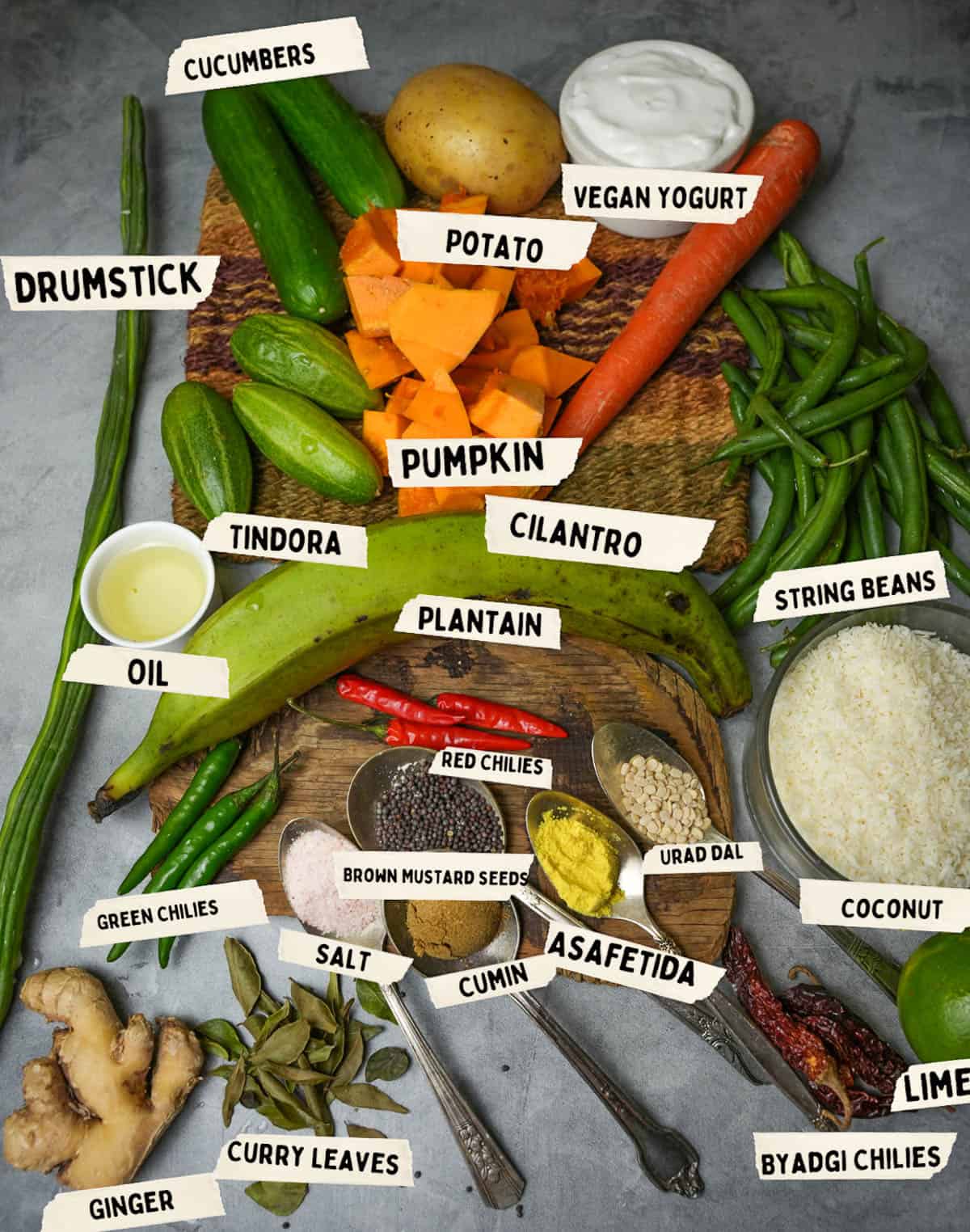
Drumstick (Muringakka or Murungai)
Drumstick, known in the West as Moringa, are long, slender pods, that add a unique flavor and somewhat okra-like texture to Aviyal. Drumstick is more fibrous than okra, and you can eat it in the Aviyal by scraping the great-tasting innards off with your teeth, and discarding the woody fibers that remain. I know I’m not making it sound awesome the way I’m describing it, but it's a uniquely nourishing ingredient and makes a great addition to sambar, rasam and many sabji preparations.
Green Plantain (Vazhakkai or Aratikaya)
Cooked green plantain (not the dark sweet plantain you might use to make Maduros) lends a delightful texture and flavor to the Aviyal. If green plantains are not accessible, you can use barely ripe bananas as a substitute. They provide a similar texture and flavor profile, enhancing the overall richness of the dish.
Tindora (AKA Kovakkai)
Tindora, also known as ivy gourd, scarlet gourd, and tondi, is a tropical vine native to India. Don't confuses it with the pointed gourd used for making parval sabji -that's different. It is a member of the Cucurbitaceae family, which also includes cucumbers, squashes, and melons. Tindora is a popular vegetable in India and other parts of Southeast Asia. It is a good source of vitamins A and C and fiber. If tindora is not readily available, you can substitute it with thinly sliced zucchini or cucumber, ensuring a similar texture and refreshing element in the dish.
Pumpkin or Ash Gourd (Mathanga or Vellai Poosanikai)
Pumpkin (or ash gourd if you can get it) brings a subtle sweetness to Aviyal. If these specific ingredients are not at hand, butternut squash or kabocha squash can be used as alternatives, offering a comparable taste and texture.
Byadagi Chilies
Dried Byadagi (or byadgi) chilies, known for their vibrant red color and mild heat, provide a gentle spiciness to the tempering oil for this dish as well as my chana dal. If you cannot find Byadagi chilies, you can substitute them with Kashmiri chilies or dried arbol chilies, ensuring a similar vibrant color and a touch of heat without overwhelming the dish.
📖 How to make perfect avial
You wanna see how this yummy thing gets made? I will walk you through the whole process. Or you can follow along with the easy-to-print recipe card towards the bottom of this page.
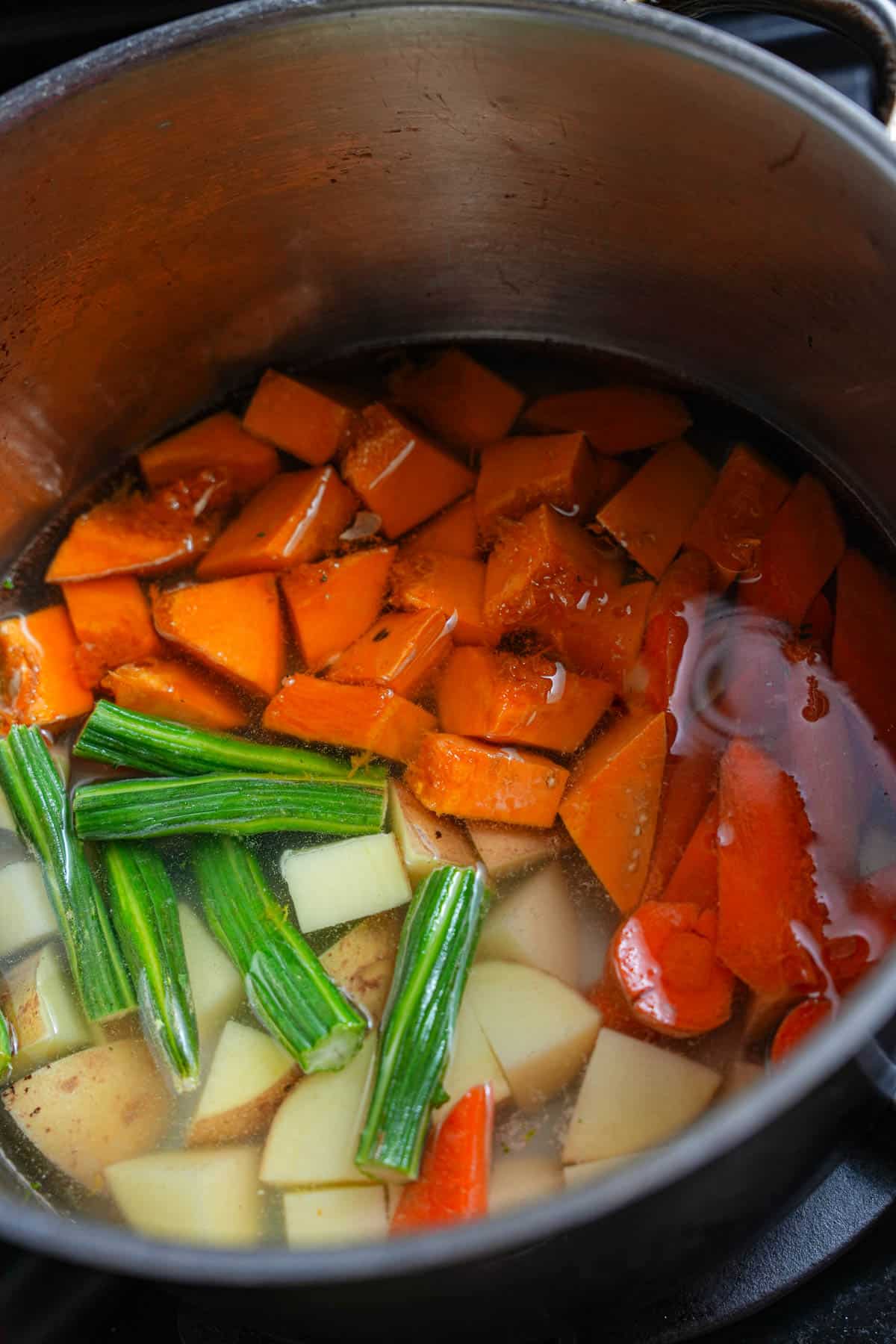
Step 1
Combine the diced potato, pumpkin (or ash gourd), chopped carrot, drumstick sections, and 2 cups of water in a pot. Bring the mixture to a boil over high heat until the potatoes become tender when pierced with a fork.

Step 2
To prepare the tindora, remove the seeds using a sharp spoon, then chop them into 1 cm. pieces.

Step 3
Add the diced green plantain (or raw banana), salt, chopped cucumbers, green beans, chopped tindora, and curry leaves to the pot. Give everything a good stir and continue to cook for an additional 5-7 minutes until the vegetables are tender, yet still retain their shape.

Step 4
While the vegetables are simmering, prepare the coconut paste. Combine the unsweetened shredded coconut (or grated fresh coconut meat), grated ginger, cumin powder, green chilies, and 1 cup of water in a blender. Blend on high speed for 90 seconds or until you achieve a smooth creamy paste-like consistency.
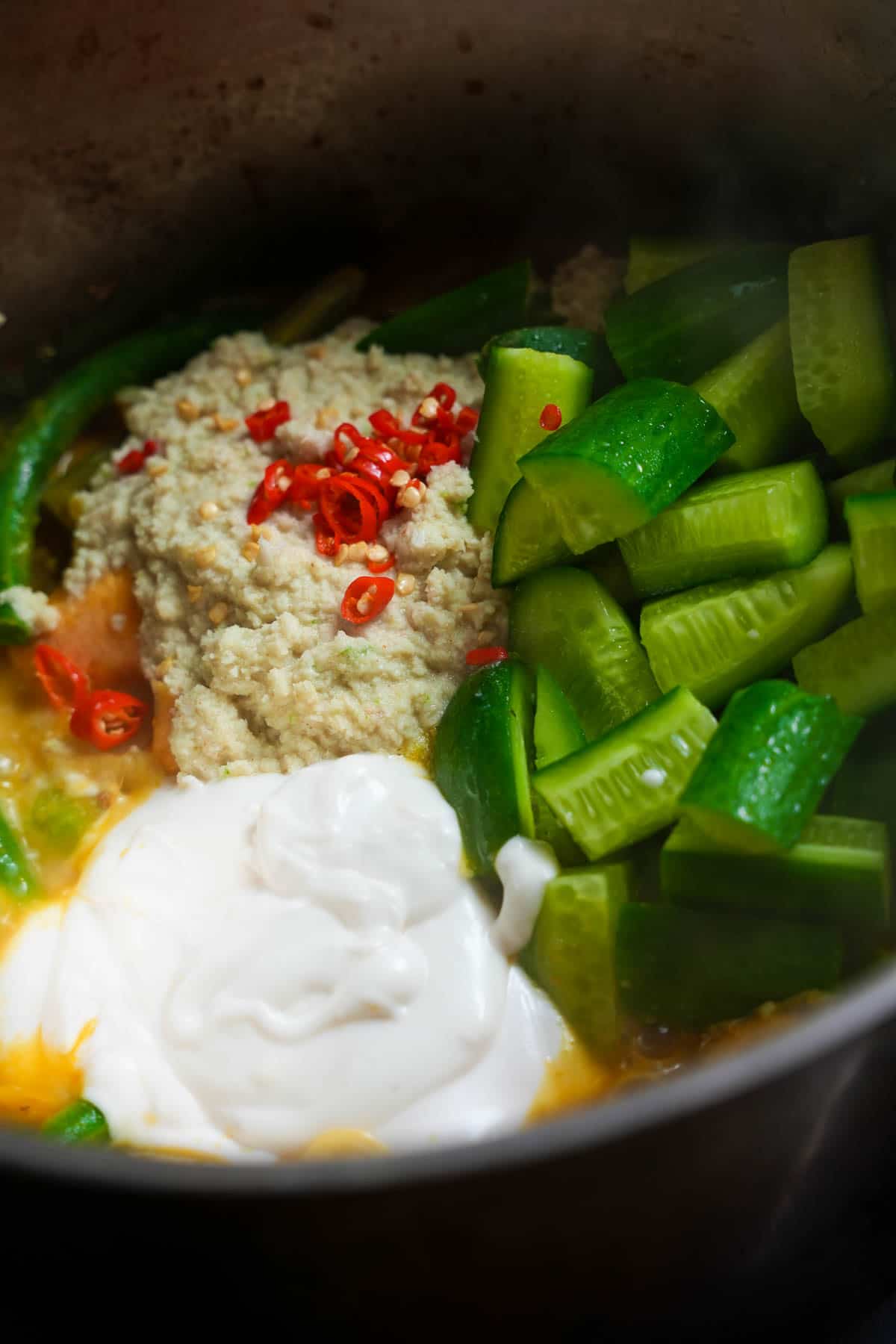
Step 5
Once the vegetables are cooked to perfection, it's time to incorporate the ground coconut paste, lime juice, and vegan yogurt (which is a healthier, more sattvic, and more compassionate choice than using curd, which many avial recipes rely on) into the pot. Gently stir everything together.
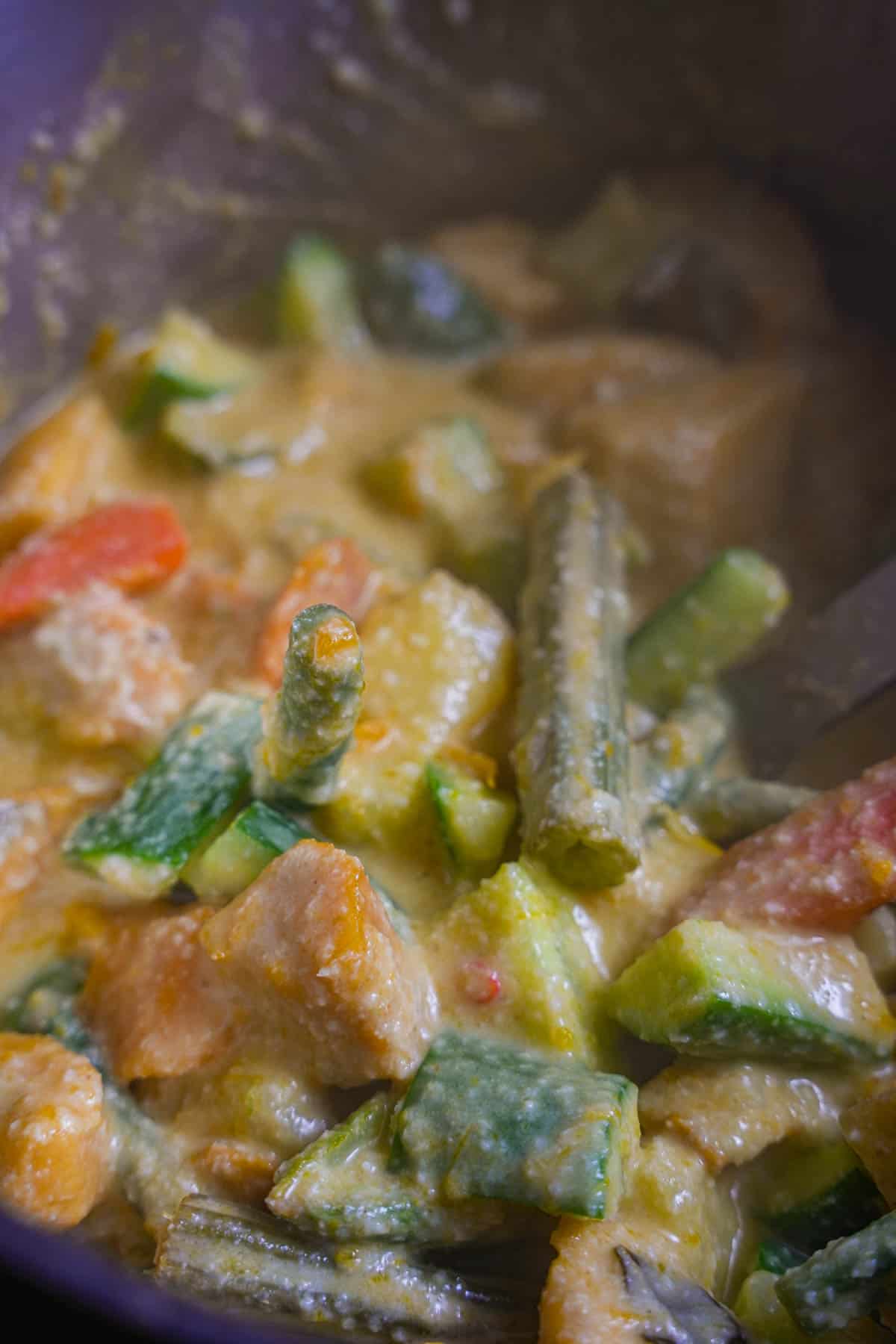
Step 6
Let the mixture simmer on low heat for another three minutes. This final cooking step ensures that the coconut paste is well-incorporated, resulting in a rich and creamy Aviyal.

Step 7
Prepare the tadka (tempering) in a separate small pan to enhance the dish's aromatic profile. Heat the coconut oil or vegetable oil over medium heat. Add the brown mustard seeds and urad dal, allowing them to crackle and pop, releasing their flavors.
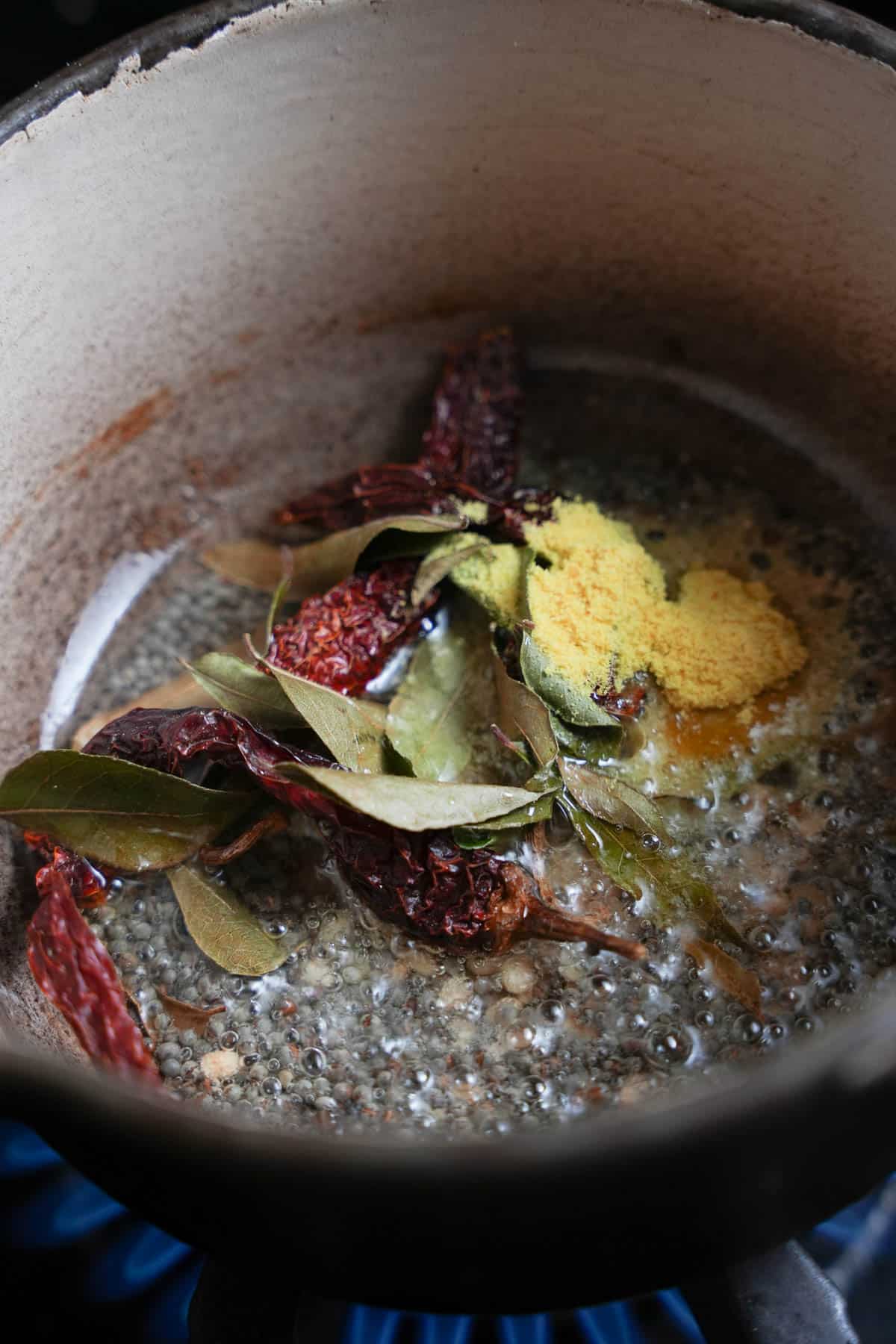
Step 8
Then, introduce the dried byadgi chilies, curry leaves, and asafoetida. Stir fry for about a minute or until the dal turns a beautiful golden brown. This tadka adds a delightful crunch and a burst of flavors to your Aviyal.

Step 9
Transfer your flavorful Kerala avial curry to an attractive serving dish and generously pour the prepared tadka over it. If desired, garnish with fresh cilantro leaves, and grated coconut.
💡Serving Ideas
Aviyal, with its vibrant medley of flavors and wholesome ingredients, pairs perfectly with various dishes.
🔥Serve it with your favorite Indian pickles such as mango, amla, green chili, or carrot pickles. Or top it with delicious, fiery shatta.
You can serve Aviyal alongside curried spinach and potatoes, my completely vegan Butter Chicken over a steaming, aromatic bowl of Sattvic Biryani, or savor it with Kerala Parotta, Amritsari Kulcha, or Msemen – bread varieties that provide a delicious canvas to enjoy Aviyal's flavors. If you want a wonderful sweet (but not sweetened) veg dish to balance some of the bitter and tangy notes of the Aviyal, consider pairing this with Shakarkandi Chaat, featuring highly spiced sweet potatoes, pomegranate seeds and sev, as a delightful contrast in flavors, colors and textures.

👉Top tip
The secret to perfectly cooked mixed vegetables is to introduce each vegetable at the right time. The denser vegetables such as carrot, potato green plantain, and drumstick should be added earlier so they have more time to become fully tender. Less hearty vegetables such as cucumber, green beans, and tindora should be added later so that by the time the potatoes cook, the cucumbers aren’t lifeless and limp.
🤷♀️FAQ
When selecting drumstick for cooking, there are a few things to look for:
👉 Size: Drumsticks should be plump and firm, with a diameter between 0.5-1 inch (1.25-2.5 cm.). Avoid drumsticks that are too thin or too large, as they may be tough or stringy.
👉 Color: Drumsticks should be a vibrant green color. Avoid drumsticks that are wilted or discolored.
👉 Skin: The skin of the drumstick should be smooth and free of blemishes. Avoid drumsticks that have a tough or bumpy skin.
Smell: Fresh moringa should have a faint fresh, grassy smell.
Serve Aviyal alongside crisp Medhu Vadai and comforting olan, lauki sabzi, or Peerkangai Kootu, a ridge gourd and lentil stew. To complete the meal, pair Aviyal with steamed coconut rice and either Toor Dal or Masoor Dal for great flavor and a ton of protein.
Fans of the two great Itihasas (The Ramayana and Mahabharata) may be familiar with the story of the origins of this dish which date back more than 5,000 years to the time of the exile of the Pandavas.
Here’s the most terribly abridged summary of who the Pandavas and Bhima are (sorry, I’d love to tell the entire story of the Mahabharata here, but that would make this recipe post a tad long…). The Pandavas, were the children of Queen Kunti, who were surrogate fathered by demigods since her husband Pandu had taken a vow of celibacy.
The demigod who was the surrogate father of Bhima was Vayu, the god of wind. Vayu impregnated Kunti with Bhima after she performed a yajna, or ritual sacrifice. Bhima was born with great strength and power, and became one of the greatest warriors in the world.
The Pandavas were exiled from Hastinapur by their jealous, power-hungry cousins, the Kauravas, and they spent many years in the forest. During their exile, they faced many challenges, and learned valuable lessons about life and their eternal connection to Krsna. Eventually, the Pandavas returned to Hastinapur and defeated the Kauravas in the Kurukshetra War (the setting of the Bhagavad Gita).
Alright. Alright, already. Lemme get to the part where Bhima created Aviyal…
During the late stages of the Pandava’s exile, they took shelter in the kingdom of Virata, taking on false identities so they were not recognized as exiled royalty. Bhima took the name Vallava and became the cook in the palace.
One day, King Virata was expecting a large group of guests for a feast. He called his cook, Vallava (who was secretly Bhima), and instructed him to prepare a delicious meal. Being a voracious eater, Bhima was also a skilled cook, but he was worried. He only had a few vegetables and some coconut, and he didn't know how he would make enough food for all the guests.
Bhima decided to be creative. He chopped up the vegetables and the coconut and then cooked them together in a pot. The guests loved it, and the dish has survived in a similar form today.
Because Itihasas are not just historical documents, but are some of the most important spiritual books, I think it is important to be accurate when citing facts from the Shastra.
Unfortunately, not all versions of the Mahabharata contain this precious culinary story. My favorite English adaptation of the epic by Krishna Dharma is heavily abridged at around 1000 pages, and doesn’t have the story. A couple of notable editions of the Mahabharata that include the story of Bhima creating aviyal are:
The Critical Edition: The Critical Edition of the Mahabharata is the most widely accepted version of the epic. It was compiled by a team of scholars under the leadership of R.P. Shastri. The Critical Edition includes the story of Bhima creating aviyal in Book 13, Chapter 31.
The Southern Recension: The Southern Recension of the Mahabharata is a version of the epic that was preserved in the southern states of India. It is believed to be older than the Critical Edition. The Southern Recension includes the story of Bhima creating aviyal in Book 13, Chapter 33.
Notably, The Kashmiri Recension does not include the story of Bhima creating aviyal.
The Kashmiri Recension of the Mahabharata is a version of the epic that was preserved in the Kashmir region of India. It is believed to be the oldest version of the epic.
Any recipe that can be traced back to Krsna and his eternal associates and is sattvic and suitable to be offered as bhoga is really special! Mentions of a few other dishes can be found in the very precious 10th canto of Srimad Bhagavata Purana.
❄️Refrigeration
Let the Aviyal to cool down to room temperature.
Transfer the Aviyal to an airtight container, ensuring it is completely sealed.
Place the container in the refrigerator.
Aviyal can be refrigerated for up to four days.
🔥Stovetop reheating
Take the desired amount of Aviyal from the refrigerator and transfer it to a saucepan or a non-stick pan.
Heat the pan on low to medium heat.
Stir the Aviyal occasionally to ensure even heating and to prevent it from sticking to the bottom of the pan.
Heat until the Aviyal is thoroughly heated and reaches your desired temperature.
Once heated, remove from the stovetop and serve immediately.
☢️Microwave reheating
Take the desired amount of Aviyal from the refrigerator and transfer it to a microwave-safe bowl in the microwave.
Using your microwave “reheat” setting, heat in intervals of 1 minute, stirring in between each interval to ensure even heating.
Continue reheating until the Aviyal is thoroughly heated and reaches your desired temperature.
Nope. Some of the vegetables will become terrible upon thawing. Just make it fresh!
✌️my favey dishes to serve with Aviyal:
Say Hi on Social! 👋
Follow me on Instagram & Facebook for more recipes.
❤️Love this recipe? It helps me out greatly if you leave a 5-star 🌟🌟🌟🌟🌟rating in the recipe card below and maybe even leave me a lovey-dovey comment too!
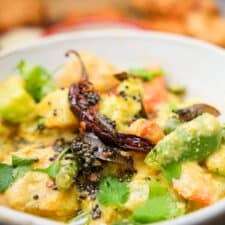
Aviyal (Kerala-style avial vegetable subji)
Ingredients
Vegetables:
- 1 Yukon gold potato diced ½ inch (1 ¼ cm.)
- 1 cup diced pumpkin or ash gourd
- 1 carrot chopped
- 1 drumstick cut into 2-inch sections (5 cm.)
- 2 cups water
- 1 green plantain or barely ripe banana, cut into 1-inch (2.5 cm.) pieces
- ½ teaspoon salt
- 2 Persian cucumbers diced
- 20 green beans stems removed
- 3 tindora chopped, seeds and inner pith discarded
- 10 curry leaves
- 1 teaspoon lime juice
- ⅓ cup unsweetened plant-based yogurt
coconut paste:
- 1 cup unsweetened shredded coconut
- 1 teaspoon grated fresh ginger
- 1 teaspoon cumin powder or cumin seeds (jeera)
- 3 green chilies hari mirch
- 1 cup water
Tadka:
- 4 teaspoons refined coconut oil or vegetable oil
- 1 ½ teaspoons mustard seeds
- ½ teaspoon split urad dal
- 3 dried byadgi chilies or other small red chilis
- 10 curry leaves
- ½ teaspoon asafetida
Instructions
- Combine the diced Yukon gold potato, diced pumpkin (or ash gourd), chopped carrot, drumstick sections, and 2 cups of water in a pot. Bring it to a boil over high heat and cook for about six minutes until the potatoes are fork-tender.
- Remove the seeds from the tindora using a sharp spoon, and then chop the tindora into 1 cm pieces.
- Add the diced green plantain, salt, chopped cucumbers, green beans, chopped tindora, and curry leaves to the pot. Stir well and continue to cook for an additional five to seven minutes until the vegetables are tender yet retain their shape.
- While the vegetables are cooking, prepare the coconut paste. In a blender, combine the unsweetened shredded coconut, grated fresh ginger, cumin powder, green chilies, and 1 cup of water. Blend on high speed for 90 seconds until you achieve a smooth paste-like consistency.
- Add the coconut paste, lime juice and yogurt to the pot with the cooked vegetables. Mix well to combine and allow it to simmer on low heat for another three minutes.
- In a separate small pan, prepare the tadka (tempering). Heat the coconut oil or vegetable oil over medium heat. Add the brown mustard seeds and urad dal and allow them to crackle and pop. Then, add dried byadgi chilies, curry leaves, and asafoetida. Stir fry for a minute or until the dal turns golden brown.
- Place the aviyal into an attractive serving dish and top it with the tadka. Garnish, if desired, with fresh cilantro leaves. If you want a more colorful aviyal, simply add a half teaspoon of turmeric powder to the coconut gravy.
Notes
- Veggie Variety: Aviyal is a colorful mix of veggies. Cut them into even-sized pieces so they cook evenly. From carrots to drumsticks, diversity is the name of the game. Aim for bite-sized, not giant chunks.
- Coconut Chronicles: Coconut is the soul of Aviyal. Grated is great, and if you can, use fresh. Mix it in at the end so it adds a creamy texture without being overpowering. Oh, and no need to squeeze out any liquid. Keep it natural.

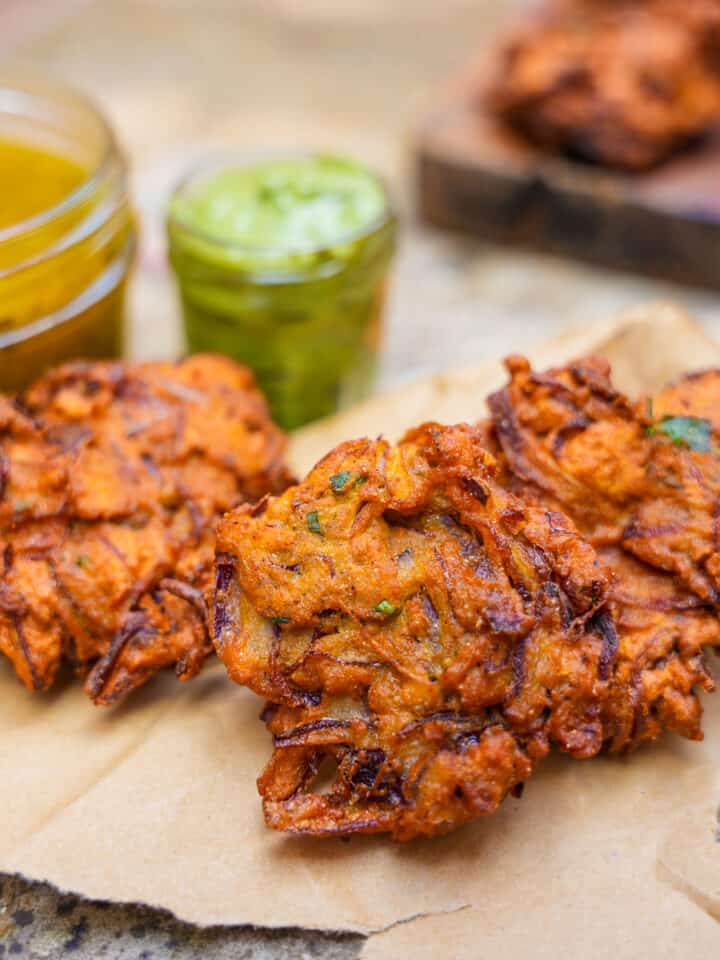
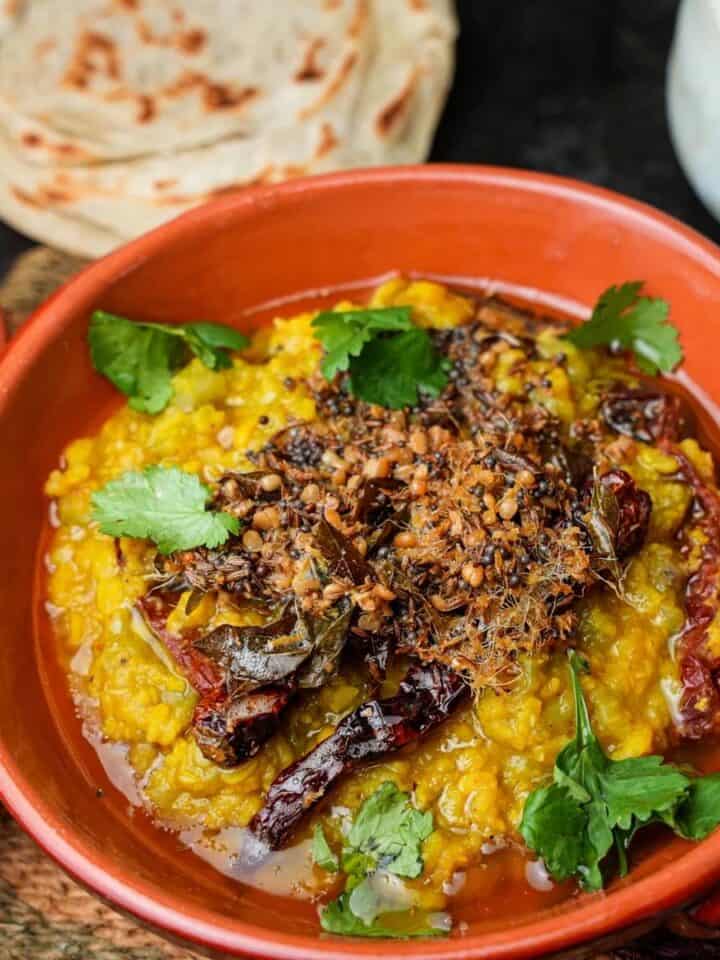

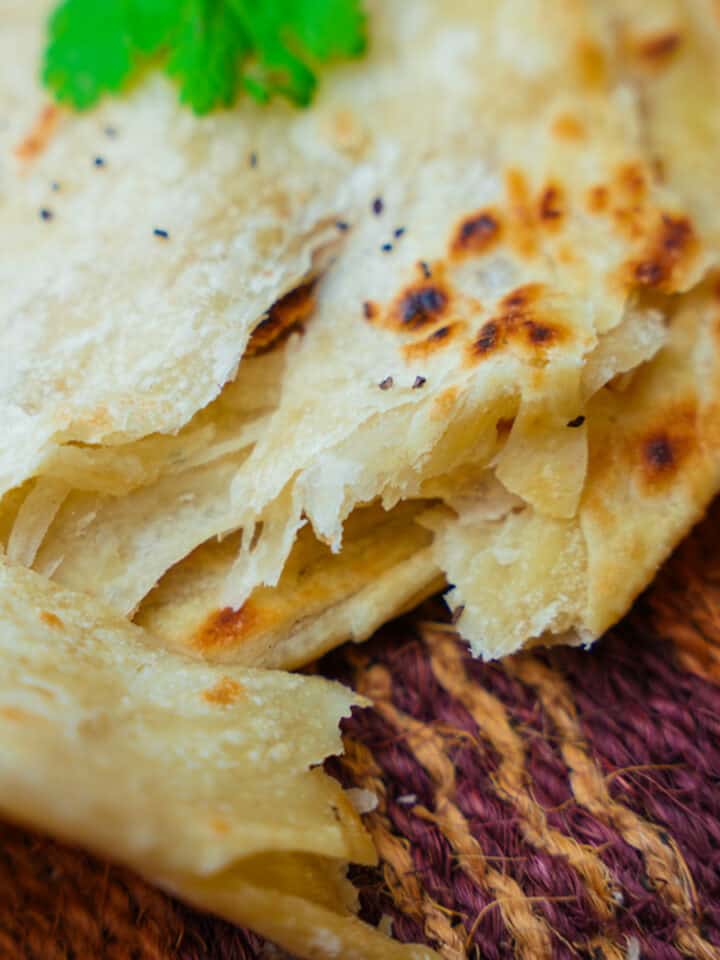
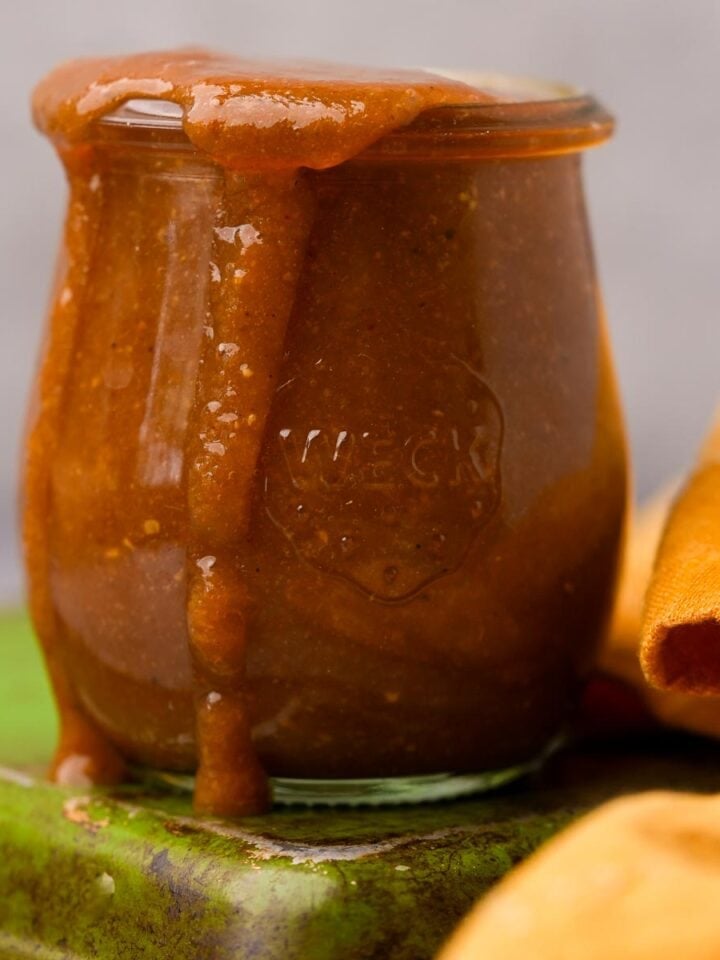
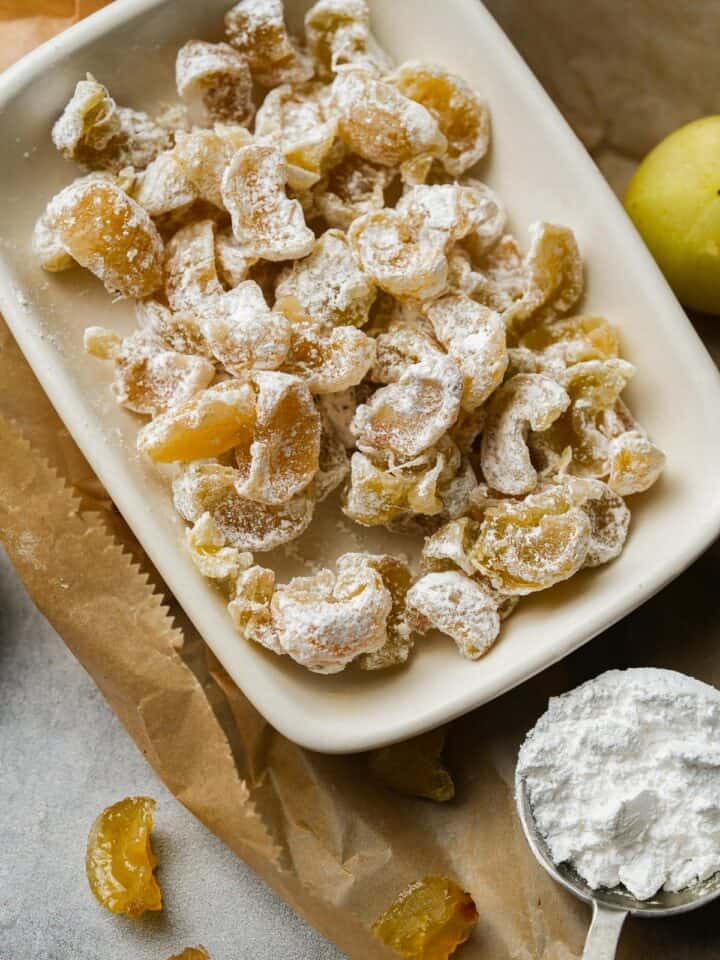
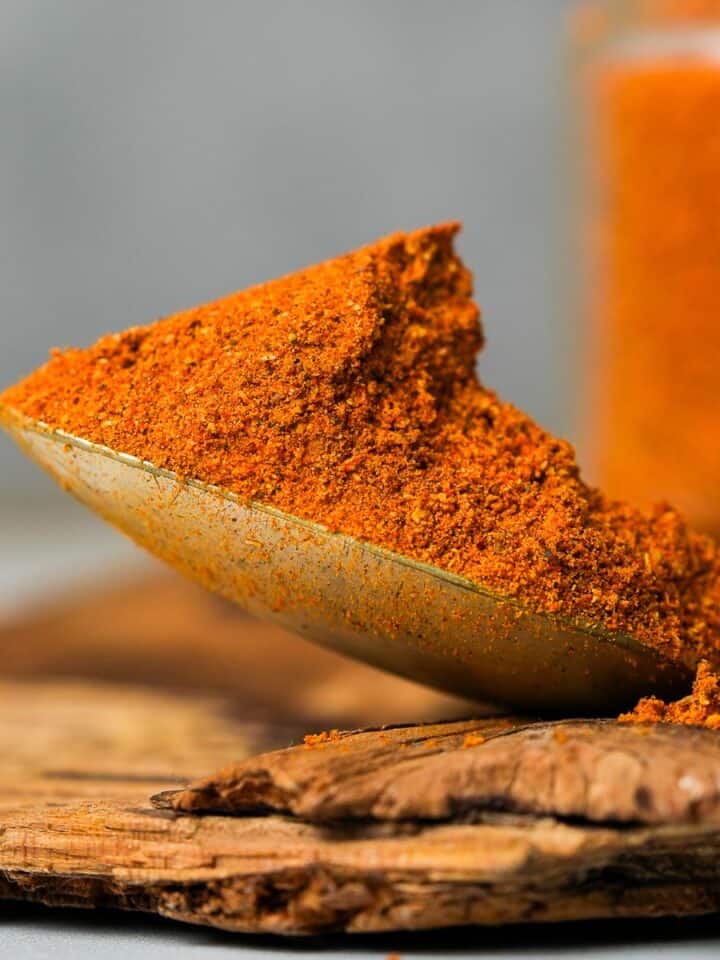
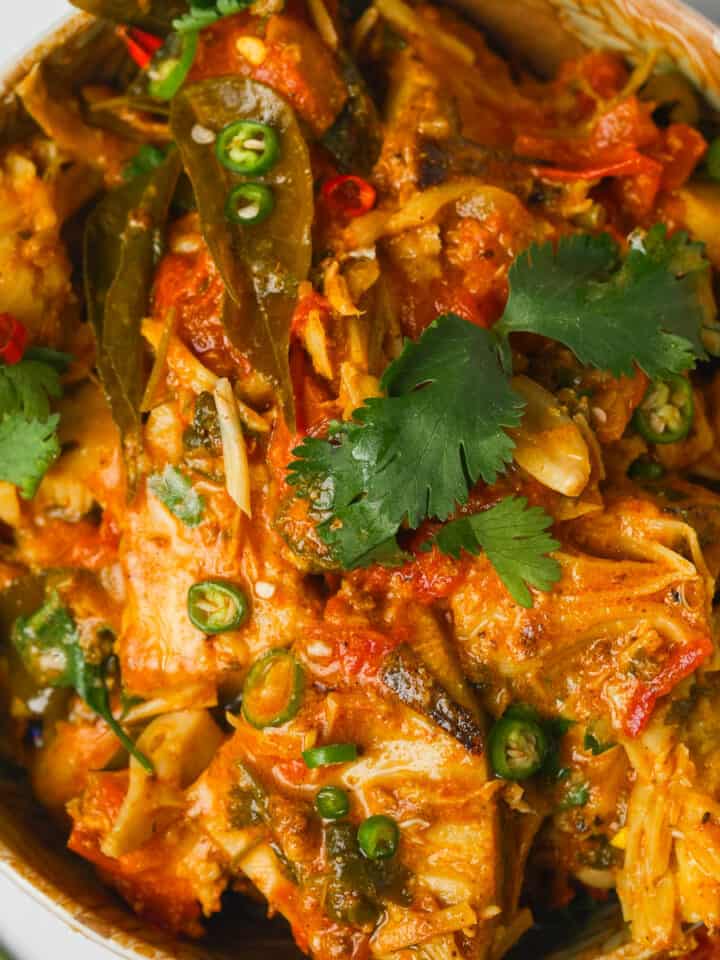

Leave a Reply